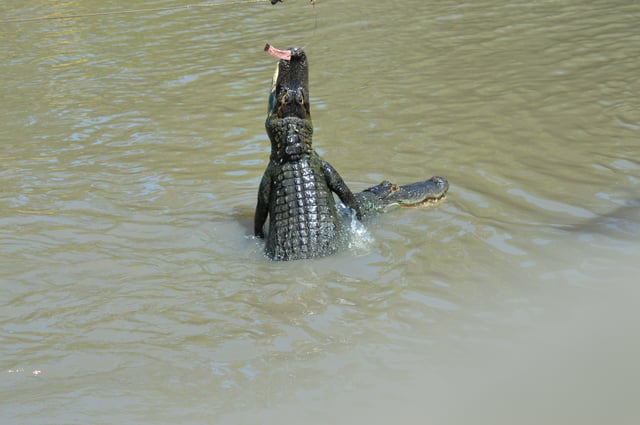You’ve reached your ultimate Florida vacation, which means one thing… time to welcome you to the Everglades! If you’ve never been, you’ll soon realize that the Everglades is a captivating ecosystem. And that it is home to two majestic reptiles: the American alligator and the more-elusive crocodile.
Have you ever wondered about the differences between these iconic creatures?
Every ecosystem has a leader and we all know who wears the crown in the Everglades. They’re big, they’re fast, they’re scary looking and they’re the king of the swamp! If you haven’t guessed who yet, it’s the American alligator. Surely no one in the water is picking a fight with these guys, and we’re exploring 4 reasons why below!
Let’s delve into the distinct characteristics that set alligators and crocodiles apart and shed light on their fascinating traits to help you unravel the mystery of these ancient predators in the Everglades and bring a little more background knowledge to your next Florida airboat adventure.

1. Physical Features and Appearance
While alligators and crocodiles may share a similar overall appearance, keen observers can spot distinct features that set them apart. Let's explore some of their physical differences first.
- Snout Shape: One noticeable difference is in their snout shape. Alligators have a wider, U-shaped snout, whereas crocodiles possess a slender, V-shaped snout. The variation in snout shape reflects their different feeding habits and ecological adaptations. Fun fact: The bite strength of alligators far exceeds the power of bites produced by humans and most other animals. To put things in perspective, the bite of an alligator has 16,460 newtons of bite pressure at a time, compared to humans, who produce 890 newtons of bite force – and that’s only when they’re biting into meat.
- Tooth Visibility: When an alligator's mouth is closed, its upper teeth remain hidden, as they fit snugly into sockets. In comparison, a crocodile's fourth tooth on the lower jaw is visible even when its mouth is closed, extending over the upper jaw. It can probably be considered the world’s most well-known underbite!
2. Habitat Preferences - Freshwater Dominance
Understanding their habitat preferences sheds light on just where you may find these incredible creatures during your Everglades airboat tour:
Alligators primarily inhabit freshwater environments, such as swamps, marshes, lakes, and rivers. They are well-adapted to the Everglades' freshwater habitats, where they thrive among the sawgrass and cypress trees. We know what you’re thinking; yes, you will find them on Lake Cypress–home to Wild Florida! While, crocodiles have a tolerance for salinity. No, we aren’t talking about finding any crocodiles sunning themselves on our local beaches. Crocodiles, however, can tolerate higher salinity levels and are occasionally found in brackish or saltwater areas within the Everglades, such as coastal regions or mangrove swamps. But, they are generally less likely to be spotted in the Everglades than alligators.

Behavioral Differences
Although alligators are often known for being king of the Everglades, the behavior of alligators and crocodiles have some pretty distinct comparisons. You may not believe this, but alligators tend to be shy and typically avoid confrontations with humans whenever possible, and are known to retreat when approached or threatened. So what else is there to know about the differences in their behaviors?
3. Aggression Levels
Alligators are known to be less aggressive compared to crocodiles. They actually like to keep their distance from situations and are more tolerant of human presence (but please know this doesn’t mean we think you should try to go near them!). Crocodiles, on the other hand, are generally more territorial and may display aggressive behavior, particularly during mating season or when defending their nests.
4. Temperature Tolerance
Alligators are more cold-tolerant and can withstand cooler temperatures than crocodiles. This ability allows alligators to have a broader range of habitats within the Everglades, while crocodiles tend to be restricted to much warmer regions.
As we break down the differences between alligators and crocodiles, we gain a deeper appreciation for these remarkable creatures (Did you know that the first alligator ancestors evolved some 245 million years ago? That really is remarkable!) that call the Everglades their home.
When you set out to embark on an airboat tour with us, you will witness the awe-inspiring presence of alligators (and possibly a crocodile or two) in the Everglades. Our knowledgeable guides will share more fascinating insights, ensuring an unforgettable journey into the realm of these magnificent reptiles during your airboat ride.




